Nouns make up about 37% of all words in English. In some types of text, such as news articles or scientific writing, nouns make up as much as 50% of all words.
What is a noun exactly?
In this blog post, we’re going to explore not just the definition of nouns but also their pivotal role in basic English grammar.
We’ll discuss what is a proper noun and what is a common noun, as well as specialized types of nouns such as countable nouns, abstract nouns, collective nouns, gerunds, and appositives.
Buckle up as we delve into how to effectively use nouns in your writing.
By the end of this article, you’ll not only have a solid knowledge of nouns but also newfound confidence in using them to enhance your language skills.
Let’s dive into the fascinating world of nouns!
Table Of Contents:
- Noun Definition: What is a Noun Exactly?
- What is a Proper Noun?
- What is a Common Noun?
- Singular vs. Plural Nouns
- Countable vs. Uncountable Nouns
- Concrete vs. Abstract Nouns
- What is a Compound Noun?
- What is a Collective Noun?
- What are Gerunds?
- What are Appositives?
- The Role of Nouns in Sentences
- Gender-Specific Nouns
- Conclusion
Noun Definition: What is a Noun Exactly?
A noun, at its root word, is the cornerstone of language. When learning the eight parts of speech, the noun is always at the top of the list.
It’s more than just an arbitrary label for things; it provides substance to our conversations and writings.
According to Merriam-Webster, a noun refers to any member of a class of words that typically can serve as the subject of verbs.
Nouns make up the largest class of words in most languages. They play several roles – from naming people (girl, prime minister) and places (beach, forest), to animals (squirrel, armadillo) and even abstract ideas (love, freedom).
In simple terms, nouns are identifiers.

A basic noun definition from Your Dictionary
Think about how we talk about our daily activities:
Did Kate enjoy swimming in your pool?
That’s two nouns right there — “Kate” and “pool”.
This world of identifiers expands even further when we consider their diverse forms.
Nouns can be:
- Common (city) or proper (San Francisco)
- Singular (dress) or plural (clothes)
- Countable (pebble) or uncountable (water)
- Concrete (chocolate) or abstract (love)
- Compound (playground) or collective (family)
Let’s dive deeper into each type of noun and learn how they can enrich your mastery of the English language.

Infographic courtesy of Thesaurus.com
What is a Proper Noun?
In simple terms, proper nouns are specific names that represent unique entities.
The capital letter in ‘Santa Claus’ is no accident – it’s an essential rule of using proper nouns. Unlike common nouns like ‘girl’ or ‘swimming pool’, proper nouns refer to a single, distinct individual, place, item, or concept.
‘Lion’ might be just another animal (common noun), but when we say ‘Simba’, suddenly there’s personality attached to it. That’s because Simba is a specific lion – hence a proper noun.
This distinction makes them deserving of their own spotlight – starting with a capital letter.
Whether it’s ‘South Africa’ representing one distinct country or ‘Coca-Cola’ standing out in the sea of beverage brands, specificity is key when it comes to proper nouns.
Here’s another way to look at it: common nouns are generic while proper nouns are specific. It’s like calling a clothing brand ‘clothing’ versus using its actual name – say, ‘Gucci’.
What is a Common Noun?
A common noun is a basic term used to refer to general items, people, places, or ideas. It refers to the most generic form of something and does not specify an individual entity.
Common nouns are one of the foundational elements in English grammar and they play a vital role in sentence construction. They can be found almost everywhere – from books and magazines to everyday conversations.
The primary characteristic that distinguishes common nouns from other types of nouns is their non-specific nature. For example, words like ‘city’, ‘dog’, and ‘school bus’ are all examples of common nouns as they refer to general categories.
Another important feature of common nouns is that they are written in lowercase. Common nouns only begin with a capital letter if they’re at the beginning of a sentence or part of a title.
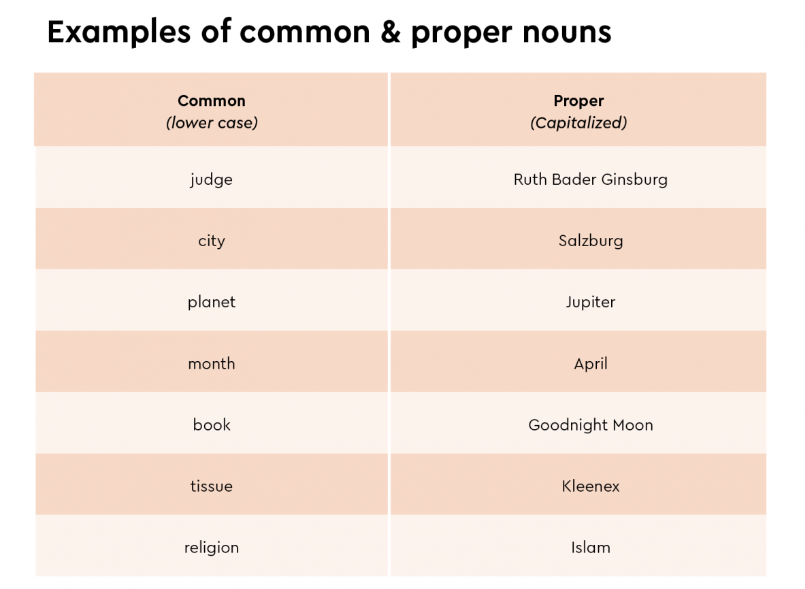
Singular vs. Plural Nouns
A singular noun, as its name suggests, refers to just one entity. It could be an individual object like a ‘book’, a single person such as a ‘teacher’, or even one place like a ‘city’.
On the other hand, plural nouns refer to more than one entity. This could mean multiple people (teachers), places (cities), or things (books).
Misusing singular and plural forms can lead to confusion when communicating your ideas clearly.
For instance, saying “The dogs barks” instead of “The dog barks” will leave listeners puzzled over whether there’s more than one dog.
The simplest rule for making nouns plural is to add an “-s” or “-es” to the end of singular nouns.
For example, “cat” becomes “cats” and “book” turns into “books”.
If the noun ends with s, x, z, ch, or sh, add “-es” instead of “-s”. So, “bus” becomes “buses”, “fox” becomes “foxes” and “church” becomes “churches”.
Here’s where it gets a little tricky.
Some words undergo more complex changes when they shift from their singular to their plural forms.
For example, ”mouse” doesn’t become ‘mouses’, instead it’s ‘mice’.
Likewise, “goose” doesn’t become “gooses” but “geese”.
We also have irregular plurals like children (from child) and teeth (from tooth). These plural nouns aren’t formed by following regular patterns.
By understanding the difference between singular and plural nouns, you’re well on your way to improving your English grammar skills!
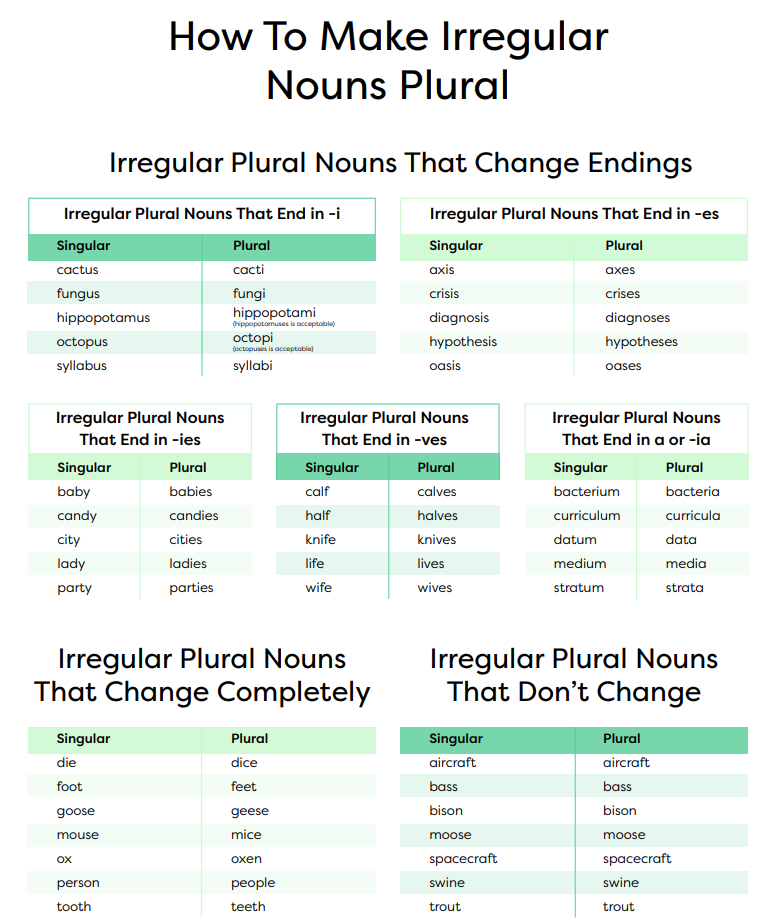
Countable vs. Uncountable Nouns
Countable nouns, as the name suggests, are items that you can count. These include objects like a ‘book’, ‘apple’, or ‘dog’. You can have one book or two books – they’re quantifiable.
On the other hand, uncountable nouns refer to things we cannot divide into separate elements. They often denote abstract concepts (information), liquids (water), gases (air), or collective terms for groups with many parts (furniture).
A simple way to distinguish between countables and uncountables is by checking if an article (‘an’ or ‘the’) precedes them or whether they use singular/plural forms.
For instance:
‘I read a book.’ Here, the book is a countable noun because it’s preceded by an article and has a plural form (books).
‘She gave me advice.’ In this case, advice doesn’t take any articles nor does it have a plural form; thus it’s an uncountable noun.
The correct use of countable and uncountable nouns is essential in English. For instance, we can say ‘fewer apples’ but not ‘less apples’, because ‘apples’ are countable. Conversely, it’s correct to say ‘less water’, not ‘fewer water’, as water is uncountable.
Understanding the difference between these two types of nouns will significantly improve your grammar accuracy when writing or speaking English. Practice using them correctly for clearer communication!
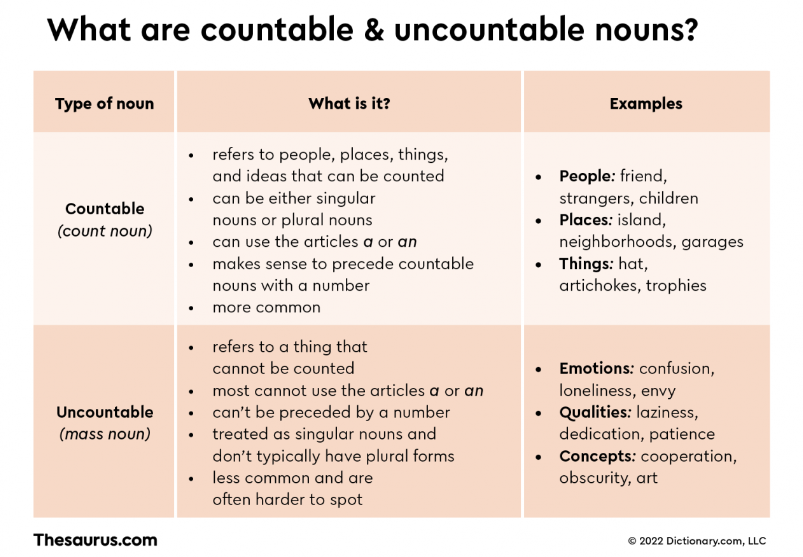
Concrete vs. Abstract Nouns
Concrete nouns relate directly to the five human senses: you can see the girl swimming in the pool just as you can feel the water splashing onto your skin.
In contrast, abstract concepts aren’t quite so straightforward because they refer not to physical things but ideas or feelings, like love which isn’t something you can see, smell, hear, or touch.
Idioms: When Concrete Nouns Become Abstract
When your everyday, tangible concrete nouns are used as idioms, they become abstract.
For instance, let’s talk about the word “heart.” In its concrete form, it’s that muscular organ pumping blood around your body. But toss it into an idiom like “heart of gold” and it transforms into an abstract concept. Here, it symbolizes kindness and generosity, moving beyond its physical existence.
Another example is “hand” which is a concrete noun that refers to a body part. Yet, in idioms like “take matters into your own hands,” it becomes an abstract noun that embodies control and responsibility.
Here are some more examples of how concrete nouns transform into abstract ones within idioms:
Concrete Noun: Time
Idiom: “Kill time”
In its concrete sense, time ticks away on your clock. In the idiom, it becomes an abstract concept of engaging in activities to pass the time.
Concrete Noun: Shoulder
Idiom: “Cry on someone’s shoulder”
Physically, shoulders bear the weight of your arms. In the idiom, it symbolizes finding comfort and support in someone during emotional moments.
Concrete Noun: Back
Idiom: “Behind someone’s back”
Literally, your back is behind you. In the idiom, it transforms into the abstract concept of doing something without someone’s knowledge.
Concrete Noun: Tongue
Idiom: “Hold your tongue”
In its tangible form, the tongue helps you taste and speak. In the idiom, it becomes an abstract instruction to refrain from speaking.
Concrete Noun: Skin
Idiom: “Get under someone’s skin”
Physically, the skin is the outer layer of your body. In the idiom, it shifts to represent a deep emotional impact or annoyance.
These examples highlight the linguistic versatility of idioms, where everyday concrete nouns morph into abstract concepts, adding layers of meaning and depth to our expressions. So, the next time you hear someone say “spill the beans” or “hit the nail on the head,” remember, they’re not talking about a clumsy cook or a carpenter but expressing something abstract through an idiom.
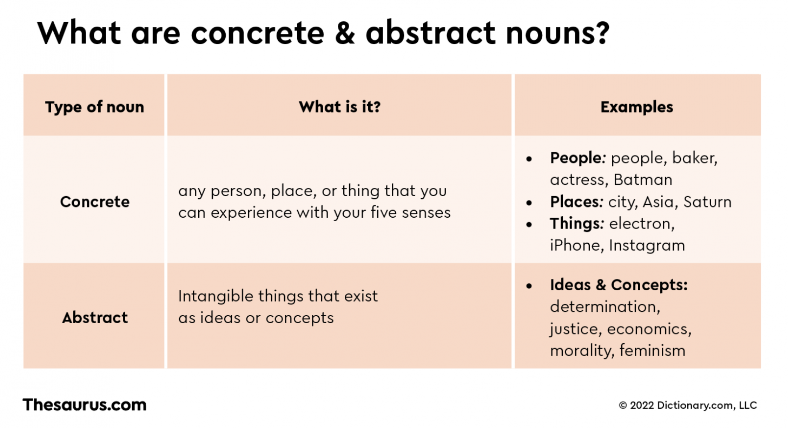
What is a Compound Noun?
Simply put, compound nouns are formed by combining two or more words to create a new, single noun.
Compound nouns are incredibly versatile and efficient. They help us express complex ideas in a more streamlined way. Instead of using a string of words, we condense them into a single term.
For example, rather than saying “a bag for sleeping,” we simply say “sleeping bag.”
Here are a few examples of compound nouns:
Noun + Noun:
Toothpaste (tooth + paste)
Moonlight (moon + light)
Raincoat (rain + coat)
Adjective + Noun:
Redhead (red + head)
Coldwater (cold + water)
Bigfoot (big + foot)
Verb + Noun:
Swimming pool (swimming + pool)
Running shoes (running + shoes)
Sleeping bag (sleeping + bag)
Preposition + Noun:
Underworld (under + world)
Overhead (over + head)
Belowground (below + ground)
Noun + Prepositional Phrase:
Mother-in-law
Son-in-law
Passersby
Verb + Noun:
Breakwater
Fall guy
Runway
Verb + Preposition:
Takeoff
Check-in
Hangover
These examples showcase how compound nouns can arise from various combinations, providing a more concise and specific way to express certain concepts.
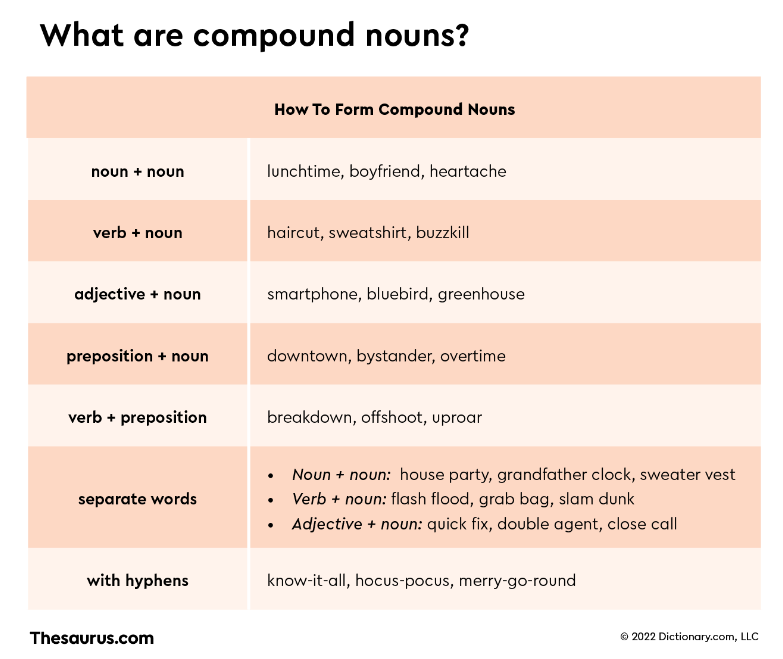
What is a Collective Noun?
A collective noun is a noun that refers to a group of people or things as a single unit. They’re singular in form but represent a collection of individuals.
Some common examples of collective nouns include team, herd, flock, family, and class.
Collective nouns are singular in form so they are used with singular verbs even though they refer to a group of things.
Here are some examples of how collective nouns are used in a sentence:
The team celebrated their victory with a pizza party.
The class was attentive and engaged during the lecture.
The audience cheered loudly as the actor took the stage.
The crowd gathered to watch the fireworks display.
The band played their hearts out at the concert.
The herd of cattle grazed peacefully in the meadow.
Collective nouns can be a great way to add variety and interest to your writing. They can also be used to create a sense of unity or cohesion.

What are Gerunds?
In the realm of grammar, there exist many elements that add depth and meaning to our language. One such element is the gerund.
But what exactly is a gerund?
Simply put, a gerund is a noun formed from a verb by adding “-ing”. It can function as a subject, an object, or a complement within a sentence.
To understand how gerunds work in sentences let’s look at some examples:
- Running helps me clear my mind.
- I love dancing.
- Helen’s favorite pastime is baking.
In each case above, the word ending with “-ing” functions like any other noun: it could be replaced with words like “activity”, “game”, or “exercise”. The main difference here is that these nouns imply action because they originate from verbs.
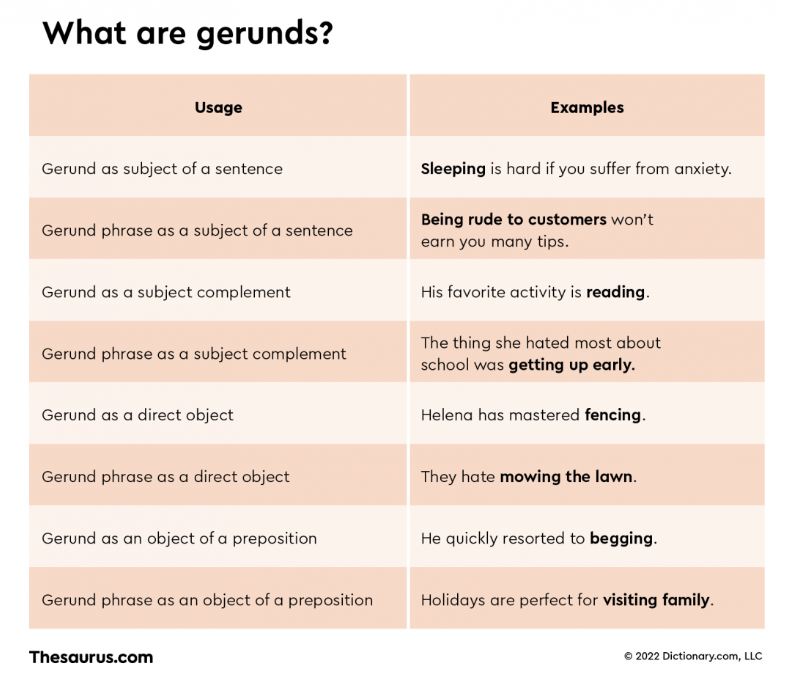
What are Appositives?
An appositive is a noun or noun phrase that renames another noun right beside it. The appositive can be a short or long combination of words. Its primary role in sentence structure is to provide additional information about the preceding noun, thus adding context and depth to your writing.
For example:
“My brother, an engineer, fixed my computer.”
The phrase “an engineer” acts as an appositive for “my brother.” This not only tells us who did the action but also gives extra details about them.
There are two main types of appositives: restrictive (or essential) and nonrestrictive (or nonessential).
Restrictive appositives contain information crucial to understanding the sentence’s meaning; without them, comprehension would be affected.
Nonrestrictive ones offer extra data that could be removed without altering the core message.
Punctuation plays a significant role when using appositives in sentences. Nonrestrictive ones should always be set off by commas because they’re optional additions.
In contrast, restrictive appositives don’t need any punctuation since their removal would change the meaning of the sentence.
To illustrate:
“I gave it to John Smith, my boss.”
“She loves her dog Rover.”
These examples show how appositives can be used to clarify who or what is being referred to, enhancing understanding and adding color to your prose.
In the first example, “my boss” clarifies who John Smith is. In the second, “Rover” specifies which dog she loves.
Appositives are a powerful tool in any writer’s arsenal. They provide additional information about other nouns in sentences – offering clarification and contributing depth of detail that enriches one’s writing style.
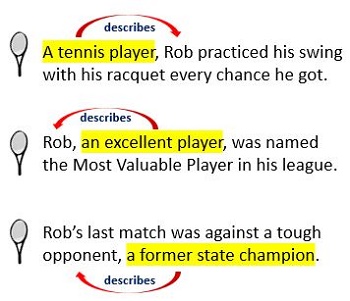
A few examples of appositives from Study.com
The Role of Nouns in Sentences
Nouns, the heavy lifters of language, have a crucial role to play in English. They form the backbone of our sentences by serving as subjects and objects.
Nouns as Subject and Subject Complement
A noun often acts as the subject in a sentence – it’s what we’re talking about. For instance, ‘The girl enjoys swimming at the pool.’
In addition to being subjects, nouns can also be subject complements that describe or identify them after linking verbs. Like in ‘My pet animal is a reptile‘ – here ‘reptile‘ refers back to ‘pet animal’.
Nouns as Direct and Indirect Objects
A direct object receives an action directly from the verb. In ‘I admire South Africa’s prime minister’, ‘prime minister’ gets admiration straight away.
An indirect object benefits indirectly from this action: ‘I sent my friend (indirect) an email (direct).’
Now you might ask yourself why any non-grammarians need this info. But let me tell you, understanding these nuances will elevate your writing game.
Think creatively with your nouns; use more concrete ones when possible for added sensory detail (‘dance practice‘ vs. just ‘practice’) but don’t shy away from abstract concepts either.
Gender-Specific Nouns
While English largely lacks grammatical gender, some words still carry inherent male or female connotations. Take ‘actor’ and ‘actress’, for instance – one refers to men, the other to women.
This division reflects societal roles but can also be restrictive. Such distinctions may sometimes reinforce stereotypes rather than challenge them.
Moving Towards Neutrality
In recent times, there has been an effort to employ more gender-neutral language to promote equality and reduce bias.
A classic example is the shift from ‘stewardess’ to ‘flight attendant’. This change signifies recognition of both genders performing this role equally well.
To break free from linguistic tradition, some folks prefer to say “performer” instead of “actor” or “actress,” or “server” instead of “waiter” or “waitress”.
It’s all part of an effort to make language more inclusive and not assume someone’s job or identity based on their gender. Because, let’s be real, a good performance or service isn’t about whether you’re a guy or a girl – it’s about talent and skill.
Many nouns are, in fact, neutral. Take ‘teacher’ or ‘doctor’, for example.
In the end, whether you’re sticking with the classics or embracing the new, the goal is to communicate with respect and understanding.
Conclusion
We’ve journeyed through the world of nouns and its various forms. We dove into proper and common nouns, their countable and uncountable types, as well as concrete and abstract variations.
Nouns are everywhere — they’re key players in our everyday conversation and help structure sentences while painting vivid images for your readers.
The next time you review text material, make sure your message is clear, concise, and does not leave the reader scratching their head.
And don’t be afraid to inject a bit of personality! AI may be brilliant at writing but it often lacks that human touch. Throw in some flair, a dash of humor, or a sprinverkle of charming nouns – whatever fits the vibe you’re going for.
Writing with BrandWell? Read its first draft aloud before publishing. Your ears can catch what your eyes might miss. If it sounds smooth and flows like a conversation, you’ve nailed it!